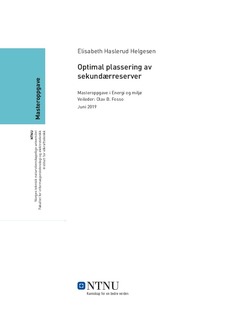| dc.contributor.advisor | Fosso, Olav B. | |
| dc.contributor.author | Helgesen, Elisabeth Haslerud | |
| dc.date.accessioned | 2019-10-23T14:01:11Z | |
| dc.date.available | 2019-10-23T14:01:11Z | |
| dc.date.issued | 2019 | |
| dc.identifier.uri | http://hdl.handle.net/11250/2624000 | |
| dc.description.abstract | For å opprettholde frekvensnivået i kraftsystemet er det nødvendig å kunne regulere produksjon på kort varsel. Reservemarkedet brukes til å utføre denne reguleringen, ved at systemoperatør kan justere produksjon ved kraftverk etter avtale med et kraftselskap.
For vannkraftprodusenter kan det være lønnsomt å inngå en slik avtale med systemoperatør. Kostnader av en slik avtale vil være tapt inntekt fra spotmarkedet ved høye strømpriser, og uønsket forbruk av vann ved lavere priser.
Ved inngått avtale om levering av volum til reservemarkedene er det interessant for kraftselskapet å finne den minst kostbare kombinasjonen av kraftverk å holde av effektvolumet ved. Fordi den tapte inntekten fra spotmarkedet er lik uavhengig av enheten volumet plasseres ved, vil optimal kombinasjon være mulig å finne ved å beregne hvilke kraftverk som gir laveste kostnad basert på vannforbruk og vannverdi ved enhetene. I denne avhandlingen ble dette gjort ved å beregne kostnader per MW som følge av vannforbruk. Aktivering av sekundærreserver (aFRR) på minuttoppløsning er beregnet som et gjennomsnitt av historiske data fra samarbeidsbedrift.
Case som ble utført bestod av tre kraftverk, og totalt åtte enheter. Datoen 13.01.2019 ble benyttet og inputverdier ble basert på data fra samarbeidsbedriften, for produksjonsplan, vannverdier, vannstand og målinger av vannføring.
Resultatet ble å beholde initiell kjøreplan, men å endre magasin ved ett av kraftverkene. Kostnaden som følge av vannforbruk ville ved initiell kjøreplan og ingen aktivering ha et gjennomsnitt på 48,9 EUR/MWh, høyeste kostnad lik 50,4 EUR/MWh og minste kostnad lik 46,8 EUR/MWh. Etter justert plan og medregnet aFRR aktiveringen ble kostnaden beregnet til å ha et gjennomsnitt på 48,1 EUR/MWh. Med høyeste kostnad lik 50,0 EUR/MWh og laveste kostnad lik 45,4 EUR/MWh.
Resultatene viste seg å være sterkt avhengige av initiell spotplan, vannverdi og virkningsgrad. | |
| dc.description.abstract | To maintain the frequency level in the power grid, it is necessary to be able to regulate the production level at short notice. The reserve market is used to do this regulation. The transmission system operator (TSO) adjust production at power plants given contract with a power company.
For the hydropower company it can be profitable to enter into a contract like this with the TSO. Costs of such a contract will be loss of income from the spot market at high power prices, and unwanted use of water at low power prices.
By signing an agreement on delivering reserves it is interesting to the power company to find the least costly combination of units to place the power volume at. Because the lost income from the spot market is the same, independent of which unit the volume is placed, the optimal combination will be possible to find by calculating which units gives the lowest cost based on water usage and water value at the units. In this thesis this was done by calculating costs in Euros per MW, as a consequence of the water consumption. Activation of secondary reserves (aFRR) is calculated as an average of historical data from the collaboration company.
The case situation studied in this thesis contained three hydro power plants, and a total of eight units. The date 13.01.2019 was used and input was based on data from the collaboration company, on production plans, water values, water level and measurements on water flow.
The result showed that the initial production plan should be kept, but that one of the reservoirs should be changed with another reservoir, due to a higher water level and better efficiency. The cost of the water consumption, when considering the initial plan and no activation of reserves, would have an average of 48,9 EUR/MWh. The highest cost was 50,4 EUR/MWh and the lowest cost was 46,8 EUR/MWh. After running the model, production plan was adjusted and activation was included, the average cost was 48,1 EUR/MWh. The maximum cost in this case was 50,0 EUR/MWh and the minimum cost was 45,4 EUR/MWh.
The results were strongly dependent on initial production plan, water value and plant efficiency. | |
| dc.language | nob | |
| dc.publisher | NTNU | |
| dc.title | Optimal plassering av sekundærreserver | |
| dc.type | Master thesis | |
